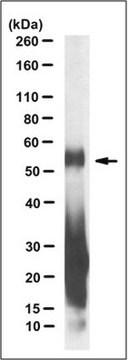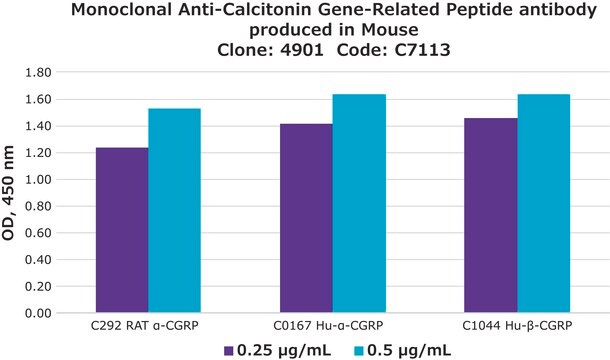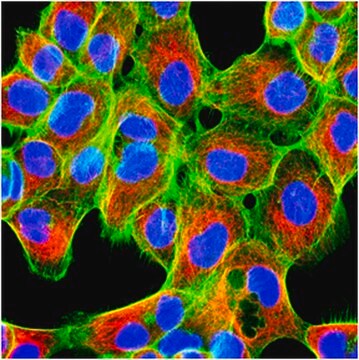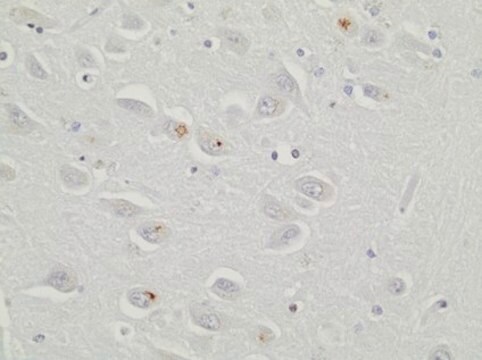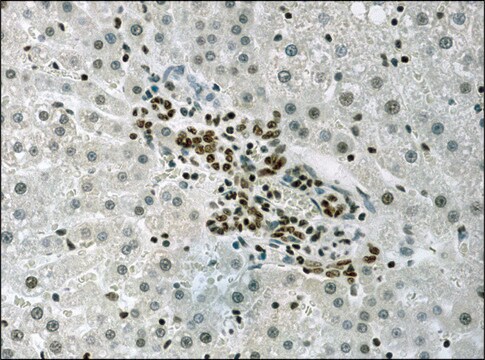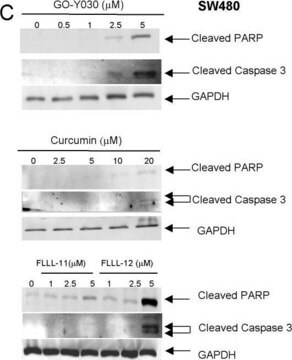おすすめの製品
詳細
Expansion of a GGGGCC (G4C2) hexanucleotide repeat sequence in the non-coding region of human chromosome 9 open reading frame 72 or C9orf72 (also known as ALSFTD, FTDALS; Gene ID 203228) is the most common genetic abnormality in familial and sporadic frontotemporal dementia (FTD) and motor neuron disease (MND), with amyotrophic lateral sclerosis (ALS) as the most frequent form. The number of hexanucleotide repeats in the normal population ranges from 2 to 24, whereas up to several thousand repeats (700 - 4,400 repeats) are found in the pathologically expanded allele. Unconventional repeat-associated non-ATG-initiated translation (RANT) of the GGGGCC repeats in the three alternate reading frames from both sense and antisense transcripts generates five types of dipeptide repeat (DPR) protein species, each composed of repeating units of two amino acids, glycine-alanine (GA), glycine-proline (GP), glycine-arginine (GR), alanine-proline (AP), proline-arginine (PR), respectively. The sense transcript (5′-GGGGCC-3′ hexanucleotide repeats) is translated through repeat-associated non-ATG (RAN) translation such that poly- (Gly- Ala), poly-(Gly-Pro), and poly-(Gly-Arg) proteins were produced. The anti-sense transcript (containing 5′-GGCCCC-3′ (G2C4) hexanucleotide repeats is translated through repeat-associated non-ATG (RAN) translation producing poly-(Pro-Ala), poly- (Pro- Arg), poly- (Gly- Pro) proteins. RAN proteins with the GP repeat motif are predicted in both the sense and antisense directions (GPsense and GPantisense)The antisense proteins accumulate in cytoplasmic aggregates in affected brain regions, including the frontal and motor cortex, hippocampus, and spinal cord neurons.
特異性
This polyclonal antibody recognizes C9ORF72/C9RANT (poly-GR).
免疫原
Ac-RGRGRGRGRGRGRGRGRC-amide.
Epitope: unknown
アプリケーション
Research Category
ニューロサイエンス
ニューロサイエンス
Anti-C9ORF72/C9RANT (Poly-GR), Cat. No. ABN1361, is a highly specific rabbit polyclonal antibody that targets C9ORF72 ( -GR sense) and has been tested in Immunofluorescence, Immunohistochemistry, Immunocytochemistry, and Western Blotting.
Western Blotting Analysis: A representative lot detected C9ORF72/C9RANT (Poly-GR) in Western Blotting applications (Zu, T., et. al. (2013). Proc Natl Acad Sci USA. 110(51):E4968-77).
Immunohistochemistry Analysis: A representative lot detected C9ORF72/C9RANT (Poly-GR) in aggregates found in neurons of the CA and DG regions of the hippocampus (Zu, T., et. al. (2013). Proc Natl Acad Sci USA. 110(51):E4968-77).
Immunofluorescence Analysis: A representative lot detected C9ORF72/C9RANT (Poly-GR) in V5-GR-Ct Transfected HEK293T (Zu, T., et. al. (2013). Proc Natl Acad Sci USA. 110(51):E4968-77).
Immunocytochemistry Analysis: A 1:500 dilution from a representative lot detected C9ORF72/C9RANT (Poly-GR) in V5-GR-Ct transfected HEK293. (Courtesy of Dr Laura P.W. Ranum and Dr. Lien Nguyen from the University of Florida).
Immunohistochemistry Analysis: A representative lot detected C9ORF72/C9RANT (Poly-GR) in aggregates found in neurons of the CA and DG regions of the hippocampus (Zu, T., et. al. (2013). Proc Natl Acad Sci USA. 110(51):E4968-77).
Immunofluorescence Analysis: A representative lot detected C9ORF72/C9RANT (Poly-GR) in V5-GR-Ct Transfected HEK293T (Zu, T., et. al. (2013). Proc Natl Acad Sci USA. 110(51):E4968-77).
Immunocytochemistry Analysis: A 1:500 dilution from a representative lot detected C9ORF72/C9RANT (Poly-GR) in V5-GR-Ct transfected HEK293. (Courtesy of Dr Laura P.W. Ranum and Dr. Lien Nguyen from the University of Florida).
品質
Evaluated by Western Blotting in transfected HEK293 cell lysate.
Western Blotting Analysis: A 1:1,000 dilution of this antibody detected C9ORF72/C9RANT (Poly-GR) in 10 µL of lysate from HEK293 cells transfected with Flag-GR construct.
Western Blotting Analysis: A 1:1,000 dilution of this antibody detected C9ORF72/C9RANT (Poly-GR) in 10 µL of lysate from HEK293 cells transfected with Flag-GR construct.
ターゲットの説明
~17.5 kDa observed. Uncharacterized bands may be observed in some lysate(s).
物理的形状
Unpurified
Rabbit polyclonal antiserum with 0.05% sodium azide.
保管および安定性
Stable for 1 year at -20°C from date of receipt.
Handling Recommendations: Upon receipt and prior to removing the cap, centrifuge the vial and gently mix the solution. Aliquot into microcentrifuge tubes and store at -20°C. Avoid repeated freeze/thaw cycles, which may damage IgG and affect product performance.
Handling Recommendations: Upon receipt and prior to removing the cap, centrifuge the vial and gently mix the solution. Aliquot into microcentrifuge tubes and store at -20°C. Avoid repeated freeze/thaw cycles, which may damage IgG and affect product performance.
その他情報
Concentration: Please refer to lot specific datasheet.
免責事項
Unless otherwise stated in our catalog or other company documentation accompanying the product(s), our products are intended for research use only and are not to be used for any other purpose, which includes but is not limited to, unauthorized commercial uses, in vitro diagnostic uses, ex vivo or in vivo therapeutic uses or any type of consumption or application to humans or animals.
適切な製品が見つかりませんか。
製品選択ツール.をお試しください
保管分類コード
12 - Non Combustible Liquids
WGK
WGK 1
適用法令
試験研究用途を考慮した関連法令を主に挙げております。化学物質以外については、一部の情報のみ提供しています。 製品を安全かつ合法的に使用することは、使用者の義務です。最新情報により修正される場合があります。WEBの反映には時間を要することがあるため、適宜SDSをご参照ください。
Jan Code
ABN1361:
試験成績書(COA)
製品のロット番号・バッチ番号を入力して、試験成績書(COA) を検索できます。ロット番号・バッチ番号は、製品ラベルに「Lot」または「Batch」に続いて記載されています。
Shuangxi Li et al.
Cell reports, 32(5), 107989-107989 (2020-08-07)
Amyotrophic lateral sclerosis (ALS) manifests pathological changes in motor neurons and various other cell types. Compared to motor neurons, the contribution of the other cell types to the ALS phenotypes is understudied. G4C2 repeat expansion in C9ORF72 is the most
Maya Maor-Nof et al.
Cell, 184(3), 689-708 (2021-01-23)
The most common genetic cause of amyotrophic lateral sclerosis (ALS) and frontotemporal dementia (FTD) is a GGGGCC repeat expansion in the C9orf72 gene. We developed a platform to interrogate the chromatin accessibility landscape and transcriptional program within neurons during degeneration.
ライフサイエンス、有機合成、材料科学、クロマトグラフィー、分析など、あらゆる分野の研究に経験のあるメンバーがおります。.
製品に関するお問い合わせはこちら(テクニカルサービス)

